Cantaloupe loves hot weather, and they tend to spread, so you’ll want to ensure you have enough growing space, or you can train them to grow through fences or trellises vertically. Cantaloupes are the perfect addition to an edible garden. You can grow this melon at home with gentle care and a little luck.

Many gardeners save seeds from particularly favorite Cantaloupe varieties to grow year after year, but this process is not always successful because the fruit cannot produce seeds that are true to type. However, if you understand how plants are pollinated and how the seeds are treated once ripe, it is possible to successfully save and produce fresh Cantaloupe seeds for planting next year.
How to grow Cantaloupe/Muskmelon from seed to harvest
How long does it take for Cantaloupe to mature from seed?
- Cantaloupes are a simple growing special melon that can be sown directly after all the risk of frost, or you can start indoors 3 to 4 weeks before setting out. Growing Cantaloupe plants occupy a considerable space, so you should leave enough space for vines to spread. To sow in a seed tray, add a good quality potting mix to each cell and then use your finger to make a ½-inch deep hole. Most Cantaloupe cultivars take between 65 to 90 days to grow and reach maturity.
- Cantaloupe usually yields mature fruit 35 to 45 days after flowering, so it’s time to provide your plantation those 45 days while the weather is still hot. Male blooms usually appear a few days before the blooms of the first female. Plant Cantaloupe seeds throughout the sun in well-drained soil. They will need about 60 to 90 days to mature, but don’t rush things.
Can you grow Cantaloupe from a Cantaloupe seed?
- You can start Cantaloupe seeds indoors or sowing seeds directly in the garden, depending on your climate.
- To use seeds from a store-bought melon, the seeds must be harvested, cleaned, and stored properly. In addition, many grocery stores were picked before the melons were ripened, which could result in immature seeds that would not germinate.
- Once you have an over-ripe Cantaloupe, cut it open, remove the seeds, and put them in an empty bowl. Remove the remaining pulp from the seeds. Then let the seeds sit for a few minutes in a bowl of water.
How do you dry Cantaloupe seeds for planting?
- Save Cantaloupe seeds is simply letting them air dry. You should spread them in a single layer on a baking sheet or foil and place them in a dry place. The seeds will usually dry out enough in a few days.
- You can also spread the good seeds on a paper towel or screen. Let them stay dry for several days. Storing melon seeds that are not entirely dried results in mold seeds. Once the seeds are very dry, place them in a clean glass jar.
In case you missed it: 15 Common Cantaloupe/Muskmelon Plant Problems: How to Fix Them, Solutions, and Treatment
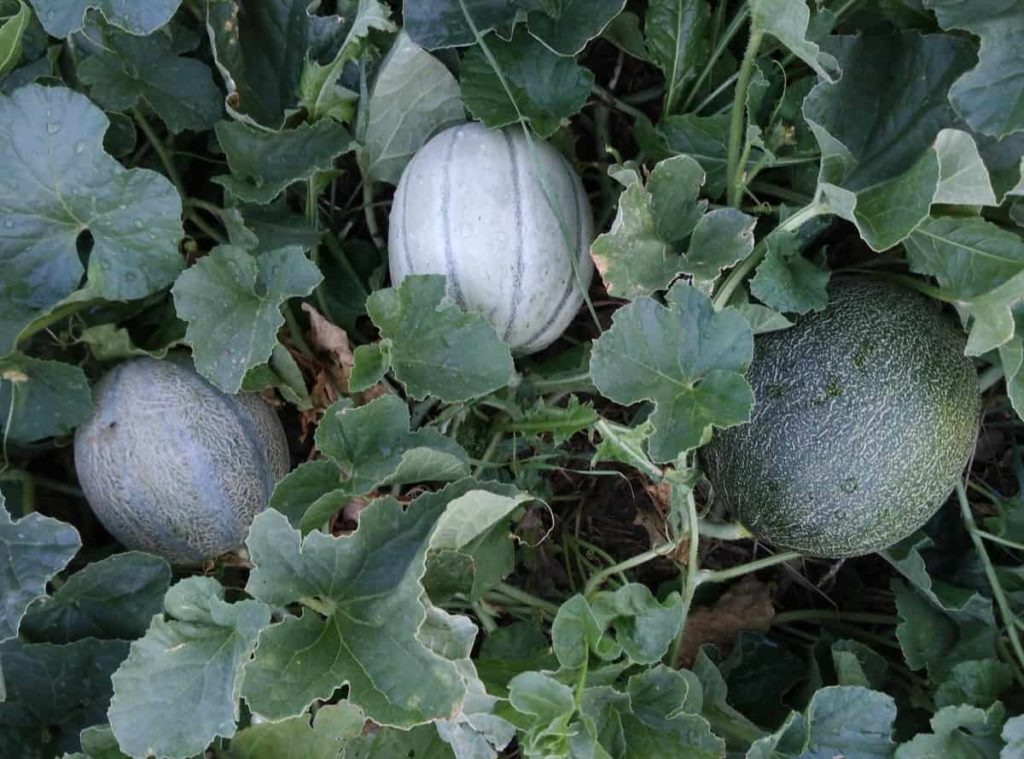
Can you grow Cantaloupe from the seeds inside?
- Direct sowing is recommended, but you can grow Cantaloupe indoors 3 to 4 weeks before the last frost in individual biodegradable pots to get a head start. Sow 2 to 3 seeds per pot. Sow seeds 1/2 inch deep in the seed starting formula. Keep the soil moist at 22°C.
- Start melon seeds indoors before transplanting them into your garden outside. Sow seeds indoors at the end of April, about 2 to 4 weeks before the last spring frost date. You can use peat pots or other biodegradable containers that you can place directly in the garden soil.
How do you grow Cantaloupe from fruit seeds?
- You should sow seeds four weeks before the last frost date in sterile seeds that mix into large seedlings pots, large soil blocks, or large seedlings tray; Cantaloupe seedlings germinate faster within 3 to 5 days. Cantaloupe seeds must go about ½ inch in depth when planted. You will plant 2 to 3 seeds per place to ensure at least one grows.
- Keep the seedlings evenly watery and very warm. Cantaloupe seeds grow best in soil temperatures from 24°C to 30°C. Most people starting melon seeds indoors need mat starting seeds to achieve this temperature.
- Keep the seedlings evenly watered and warm once the seedlings are grown. Use small snips to clip all but the strongest seedlings in each cell. After your last frost date, plant Cantaloupe seedlings 36 inches apart in the garden.
Will Cantaloupe climb a trellis?
- With a pinch of creativity and careful setup, one can train Cantaloupe to grow vertically on almost any type of trellis.
- Plants that spread on the ground are also prone to pests, fruit rot, and other diseases. Growing melons vertically, a trellis, allows for better airflow that keeps the leaves dry. In addition, the fruit is kept above wet ground and away from crawling bugs.
- When trellising the melon, tie the vine to the trellis, using a soft plant tie that won’t crush the stems. A trellis should be large for Cantaloupe: up to 8 feet long and 20 feet wide in the warmest climate. The wire fence works well.
- Small fruit Cantaloupe cultivars can grow as strong trellis or fences without the support of many (if any) fruits. For full-size Cantaloupes, you’ll want to make a hammock for each melon to help them on the trellis.
Why are my Cantaloupe plants not producing fruit?
Cantaloupe flowers but no fruit due to lack of pollination. The most common reason Cantaloupes flower is that they are not pollinated. Although perfect flowers do not require external pollination, other females on the plant do flowers.
What is the best month to plant Cantaloupe?
- Cantaloupe prefers warm weather, so don’t plant it before the temperature warms in the spring. Cantaloupe works best when sown directly. Sow seeds outside about two weeks after the last frost date when the soil temperature is about 19°C.
- To sow outdoors, plant three seeds in holes 1/2 inch deep, 18 to 24 inches apart. Keep them evenly moist until germination. Thin them, once the seedlings have two sets of true leaves, there is only one plant every 18 to 24 inches.
- While planting Cantaloupe, wait until the risk of frost is over and the soil warms up in the spring. You can either sow seeds in the garden or flats indoors or use transplants purchased from reputable nurseries or garden centers.
In case you missed it: Best Fertilizer for Cantaloupe/Muskmelon – Homemade, Organic, Liquid, NPK, Compost, How and When to Apply
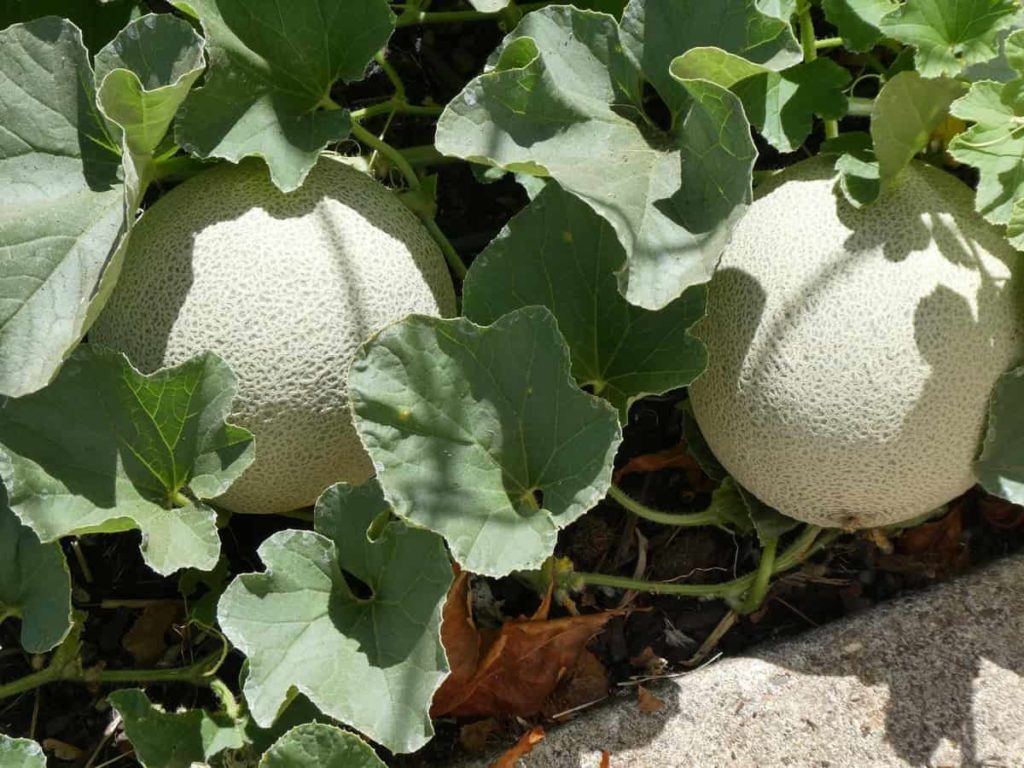
What can you not plant with Cantaloupe?
- You should not plant Cucumbers, Watermelons, or Squash near Cantaloupes, as they are susceptible to the same pests.
- Tomatoes and Peppers do not flourish with melons because melons take up so much space that they crowd them outside. Also, don’t plant melons near plants that will shade them, as they require full sunlight.
- You should not plant zucchini and summer Squash with all other vining plants, including Cucumbers and Sweet Potatoes, as well as Pumpkins, Winter Squash, and Melons.
How many Cantaloupe grow on a plant?
- Unlike other varieties, vines only extend up to three feet. You must provide them with warmth, water, and food to grow them successfully. They can be quite vigorous, so they need to be pruned regularly to keep them under control. Each plant should produce two to four melons.
- Most melons ripen from late summer or early to mid-autumn. It is common to get two to three melons per vine. Their sweetness is determined mainly during the three weeks leading up to harvest. Give them less water during this time, as these dry conditions promote sweetness.
Should I prune my Cantaloupe plant?
- Pruning Cantaloupe plants is not extremely necessary, and more leaves that live on vines are fruit sweeter. Cutting Cantaloupe plants results in less fruit which enables the plant to put all its energy into a few parts resulting in large melons.
- Another reason for pruning Cantaloupe vines is to make them easier to trellised, using either net trellis or string and vines clips. If you want to grow large melons, you should prune Cantaloupe vines. If you have too many small melons, skip pruning. Their relatives, like Watermelon, Squash, and Cucumber, Cantaloupe plants like the full sun and sandy, well-drained soil that is kept consistently moist.
- Melons produce a primary stem with many secondary or lateral branches. When pruning Cantaloupe, the purpose is to maintain the primary vine, remove the first lateral, and reduce the size of all additional secondary branches.
How often should Cantaloupe be watered?
- Cantaloupes require plenty of water, but not enough to make a soggy garden. Water your crops one to two inches per week, and water the ground directly to avoid wetting the leaves and promoting powdery mildew. Once the fruit starts growing, reduce your water, as the dry season is perfect for sweet melons.
- Cantaloupes require a lot of water, so keep the soil moist and avoid wetting the leaves; hose and drip irrigation are best. Protect young fruits by eliminating them from the ground.
- Cantaloupes require about 1 to 2 inches of water per week. The water gradually reduces and closes as the fruit matures, as too much moisture can cause the rinds to split.
- You should mulch around the plants will help conserve soil moisture and reduce the growth of weeds. Irrigate so that moisture gets deeper into the soil.
How do I keep bugs off my Cantaloupe?
- You should spray melon vines with a strong jet of water from your hose. This process is often enough to kill most melon aphids and small insects such as thrips and mites, which eat melon stems and foliage.
- Sand can be an excellent barrier for all types of insects that eat Cantaloupe. The sand is placed around the plan’s root and folded at 0.5-inch thickness. Since the sand is fine, it becomes difficult for fleas and flying insects to lay eggs around your Cantaloupe.
- It can be used for both pot and soil environments. Since melon aphids have begun to resist many pesticides, insecticidal soap or horticultural oil may be most effective for control. Adequate coverage is essential for aphid management as coarse leaves can shelter aphids from pesticide residues.
Should you mulch around Cantaloupe?
- Mulch is another factor that can be considered when Cantaloupe grows. Mulch keeps the soil warm, which these plants enjoy, and also helps maintain moisture, reduces the growth of weeds, and keeps the fruits away from the soil.
- While many people prefer to use plastic mulch when growing Cantaloupes, you can also use straws. Within about a month or so of the fruit has set, Cantaloupes should be ready for harvesting. You should keep the mulch around plants, it will help conserve soil moisture and reduce the growth of weeds. Irrigate so that moisture gets deeper into the soil.
Should I hand pollinate Cantaloupe?
- Hand-pollinating melon plants such as Watermelon, Cantaloupe, and Honeydew may seem unnecessary, but for some gardeners who have difficulty attracting pollinators, such as those who garden on high balconies or in highly polluted areas, it is necessary to hand-pollinate melons to get fruit.
- Like other vining crops like Cucumbers, Pumpkins, Squash, and Watermelon, Cantaloupes also require pollen to produce fruits. This means that pollen should be transferred from male flowers to female flowers.
In case you missed it: Growing Muskmelon Indoors from Seed – a Full Guide
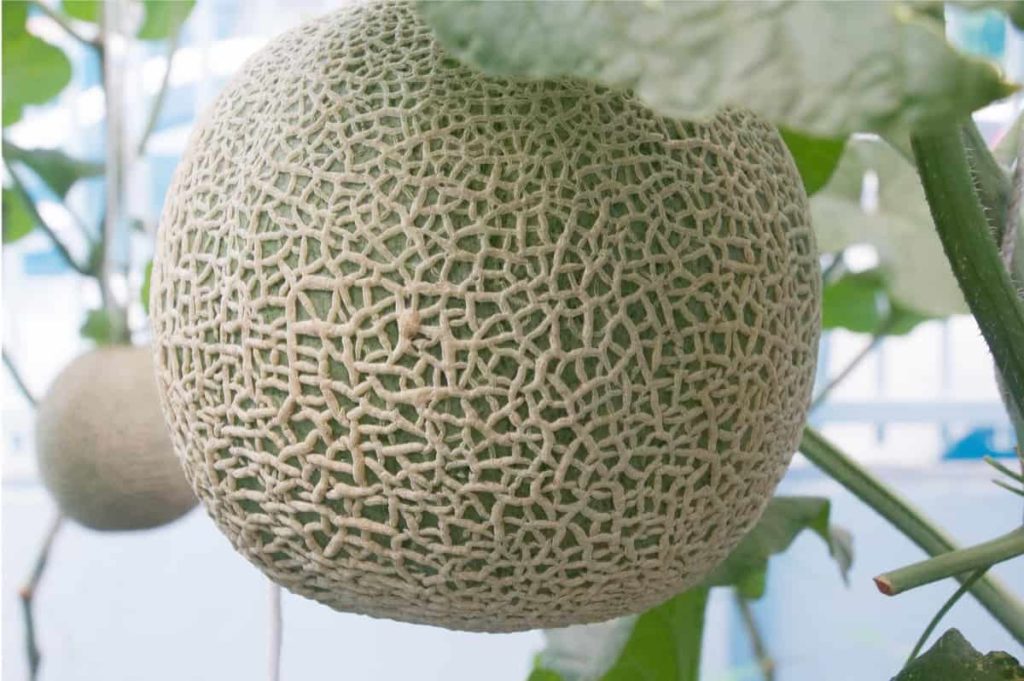
Do Cantaloupes need full sun?
- Cantaloupe plants need sunlight to produce the best melons. In addition, the afternoon sun will dry the leaves, reducing the risk of fungal diseases that come with wet leaves. Cantaloupes perform best in well-drained soils that blend between loamy and sand.
- Choose a sunny place to plant, as the melon requires eight to ten hours of full sun to thrive. You’ll first need to ensure the soil in your raised beds or old-fashioned row garden is loose, well-drained, and ready for melons.
- You should plant Cantaloupe in an area with warm soil and enough sunshine. Cantaloupes are sprawlers, so they are planted in fertile, well-drained soils at a distance of 36 to 42 inches.
How many seeds are in a Cantaloupe hole?
- Cantaloupe should be planted when the soil is 19°C, or there is a risk of frost being passed. Plant 4 to 6 seeds in mounds at a distance of 4 feet. The transplant should be placed at a distance of 2 feet in a row, with rows 4 to 6 feet apart.
- Cantaloupe seeds are large and need to go about ½ inch depth when planted. The roots emerge from the point, and if you place them rounded side down, they can still grow; the seedlings will have to work hard to figure out which way is up and which is down.
What’s the best fertilizer for watermelons and Cantaloupes?
- Cantaloupe plants are fertilized after flowers appear. At this time, you use phosphorus and potassium fertilizer. If you add nitrogen-rich fertilizer this time, the plant will grow large leaves but will not produce any fruit.
- The best fertilizing time is usually between June and July when more flowers bloom. When you see that your Cantaloupe has formed the first fruit on the plant, it’s time to fertilize again. This will help to encourage growth and get better quality melons down the line.
- Compost and well-rotten manure make the best fertilizer for Cantaloupes. You must use about 450 grams every 4 or 5 square feet. Compost and aged manure improve soil structure as well as fertility.
- For seeds or transplanted Cantaloupes, apply 45 to 60 kg per acre of 10-34-0 to enhance early growth, especially in cool soil in early spring. This should be banded 2 to 3 inches at the edge of the row and 2 to 3 inches below the roots.
Do Cantaloupes have deep roots?
- Cantaloupes have a shallow root system; mulch helps maintain soil moisture and temperature. Keep the plants well-watered during the growing season, especially during dry spells. Cantaloupe plants require about 1 to 2 inches of water per week during the growing season.
- Cantaloupe has an extensive shallow root system. When the vine is 60 centimeters long, the roots have a spread of 90 centimeters with 20 centimeters of the taproot. It completely occupies 15 to 20 centimeters of the topsoil.
Can Cantaloupes grow in pots?
- With the proper care, Cantaloupe can flourish in a container, even a small one, which means anyone, anywhere, in a house or garden of any size, can enjoy its sweet deliciousness.
- Keep the soil constantly moist until the seeds germinate, then continue to water regularly whenever the soil feels dry to the touch. Reduce irrigation when melons reach a tennis ball size; water only when the soil is dry and the leaves show signs of wilting.
- To grow Cantaloupes, you’ll need a large 16 to 18-inch pot. In a really large, 24-inch pot, you can try growing two Cantaloupes per vine. When planting, you can make trellis or cages around the pot so that they can get the right support system.
How do you increase the sweetness of a Cantaloupe?
- The melons ripen on the vines quite easily. So, if farmers pick their Cantaloupes very quickly, they won’t have the sweet, summery flavor you expect. But if melons are being picked when they ripen and are ready, the problem could be soil or water conditions.
- To encourage strong growth, you should add 4 to 6 inches of compost to your melon beds before planting. Then you can add a balanced organic fertilizer (such as blood meal and bone meal) every 3 to 4 weeks.
- Heat brings out the sweetness of melons, so be sure to plant them in a place that warms up in early spring and until the end of September. The south side of the fence or wall is the best one because this structure absorbs heat and light from the sun and reflects it on the melon.
In case you missed it: How to Grow Oranges from Seed to Harvest: Check How this Guide Helps Beginners
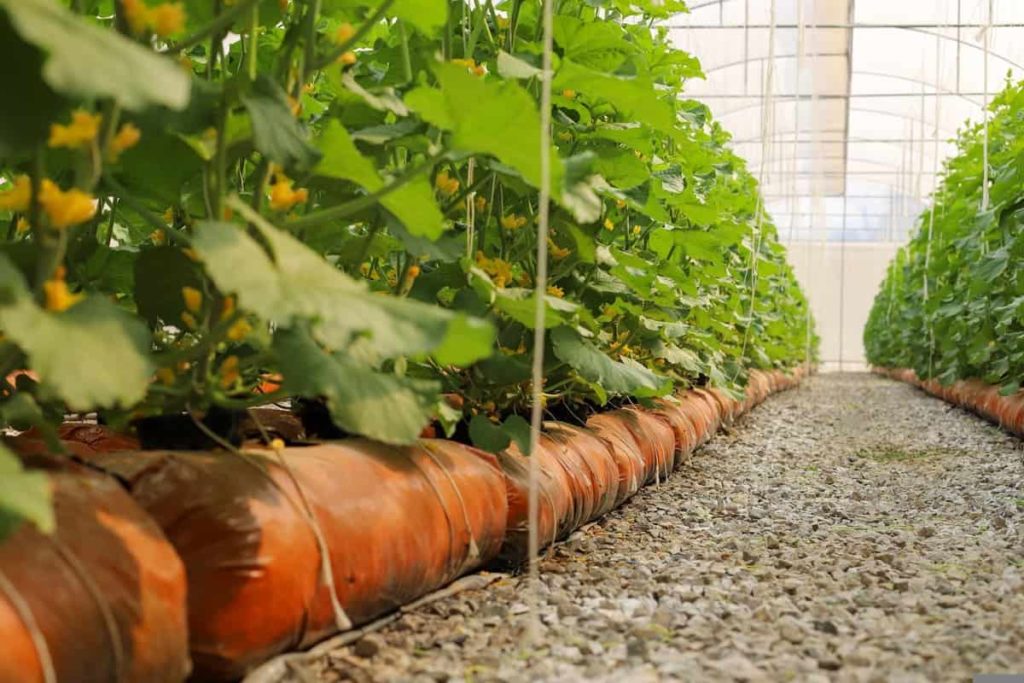
How do you grow a big Cantaloupe?
- Vine crops such as Watermelon, Cantaloupes, Winter Squash, and Cucumbers require large amounts of space.
- Plant Cantaloupe seeds throughout the sun in well-drained soil. Plants in groups of two or three seeds should be placed at a distance of 2 feet. When trellising the melon, tie the vine to the trellis, using a soft plant tie that won’t crush the stems. A trellis should be large for Cantaloupe: up to 8 feet long and 20 feet wide in the warmest climate.
- Thin seedlings and keep only the strongest seedlings in each group. Space plants at a distance of 24 to 36 inches if left to spread on the ground. Space plants are about 12 inches apart if growing up on a trellis. If square feet gardening methods are used, allow 2 to 3 square feet for each plant.
Why are my Cantaloupe rotting on the vine?
- Your Cantaloupe fruits rot on the vine because of too much water. Cantaloupe fruits are also seen rotting when it is infected with anthracnose. Even some types of insects can rot Cantaloupe fruits.
- Place fruit rest on gravel mulch instead of bare soil to avoid rotting. Keep the leaves healthy as it is a sugar source for the fruit. As the melons ripen, the leaves naturally start to look rough.
- To prevent it from rotting, elevate the fruit above the soil. You can use a fluffy layer of straw or wood chips under the fruit to increase airflow and reduce contact with the soil. Or try melons and squash cradles that raise the fruit above the ground to prevent rot and even promote ripening.
How can you tell when a Cantaloupe is ready to cut?
- The color of your Cantaloupe is the first sign of your ripening. The green color of the melon will take the creamy yellow color. If the color is correct, gently push the melon opposite from the stem. If a little needs to be given, the melon is probably ripe.
- On an unripe Cantaloupe, the stem’s end will be tightly attached and smooth at the point where it connects to the melon. As it ripens, the stem end can rise slightly from the fruit. The stem will easily separate from the melon when the melon is ripe. Many times, the melon can separate from the vines on its own.
Does Cantaloupe like sandy soil?
- Cantaloupes perform best in well-drained soils that blend between loamy and sand. Modify the soil with aged manure or compost before planting. Before planting your Cantaloupe, use loamy soil rich in well-rotted compost or aged manure to ensure that your melon has plenty of nutrients to eat in its growing season. Cantaloupes prefer slightly acidic compared to neutral soils between 6.0 and 6.8 pH.
- It grows well in deep fertile, and well-drained soil. Soil with poor drainage capacity is not suitable for Muskmelon cultivation. Follow the rotation of crops as the continuous growth of the same crop in the same field leads to nutrient loss, poor production, and the attack of excess diseases.
In case you missed it: How to Grow Papaya from Seed to Harvest: Check How this Guide Helps Beginners
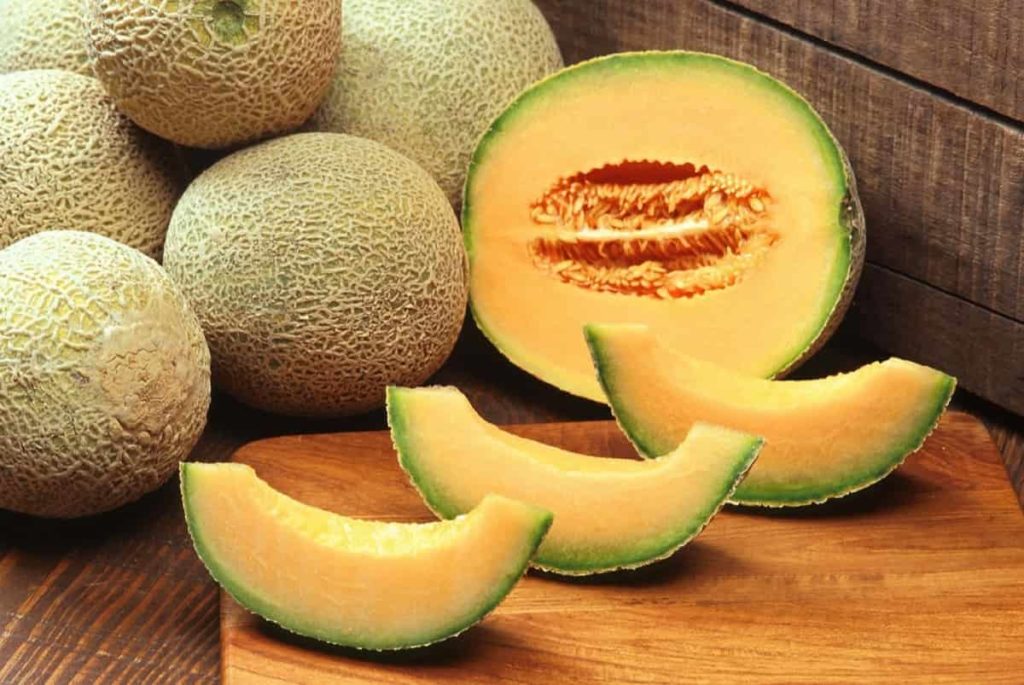
Conclusion
Cantaloupes are heat-loving plants whose season grows relatively long. As long as you provide appropriate environmental conditions, growing Cantaloupe from seeds is straightforward. Think again if you’ve never tried to plant Cantaloupe seeds because you’re worried that they won’t grow well in your climate. Over the years, growers of different Cantaloupe varieties have developed several valuable tricks for Cantaloupe cultivation in cooler climates.
- Flower Garden Designs and Layouts for Beginners
- Planting and Spacing Techniques in Papaya: A Beginner’s Guide
- Growing Gold: Essential Techniques for Planting Pineapples
- How to Make Kalanchoe Plant Bushy: Home Remedies and Solutions
- 11 Reasons Why Your Gardenia is Not Blooming: Home Remedies and Solutions
- Eco Elegance: The Guide to Designing a Drought-Tolerant Landscape
- Gardening on a Slope: Strategies for Hillside Landscaping
- Nourish and Flourish: Top Organic Mulches for Thriving House Plants
- Everything You Want to Know about Indian Mogra Flower: Discover Uses and Growing
- Green Thumb Success: Expert Tips for Cultivating Greenhouse Pumpkins All Year Round
- Maximize Growth & Flavor: The Ultimate Guide to Companion Planting in Herb Gardens
- How to Control Rhododendron Problems Naturally: Home Remedies and Organic Ways to Fix Them
- Natural Magic: The Remarkable Benefits of Cinnamon for Plants
- Best Steps to Revive Dying Tulip with Natural and Organic Treatment
- 10 Reasons Why Your Angel Trumpet is Not Blooming: Remedies and Treatment
- How to Fix Periwinkle Leaf and Flower-Related Problems: Natural Remedies and Solutions
- How to Fix Zinnias Leaf and Flower Problems: Discover Natural and Home Remedies
- Organic Steps to Induce Lemon Tree Flowers: A Comprehensive Guide
- Bloom Booster: Crafting the Perfect Homemade Bougainvillea Fertilizer
- Optimizing Growth: A Guide to Applying NPK Fertilizer for Potted Plants
- 10 Best Homemade Fertilizers for Rubber Plant: DIY Recipes and Application Method
- How to Boost Female Pumpkin Flowers: Effective Steps for More Flowers and High Yields
- Transform Your Indoor Garden: Top Benefits of Pink Salt for Houseplants
- 10 Best Homemade Fertilizers for Peacock Plants (Calathea): Easy DIY Guide
- Unlock Blooms: 9 Reasons Why Your Potted Chrysanthemum is Not Blooming
- 8 Reasons Why Your Potted Hibiscus is Not Blooming: Fix it with Simple Solutions
- Unlock Blooms: 9 Key Reasons Your Potted Frangipani Won’t Flower
- 10 Reasons Why Is My Ice Plant Not Blooming: Remedies and Treatment
- 10 Reasons Why My Potted Hydrangea Not Blooming: Treatment and Remedies
- 10 Reasons Why is My Wisteria Not Blooming: Remedies and Treatment
- 10 Reasons Why is My Goldfish Plant Not Blooming: Remedies and Treatment
- Maximize Your Space: Ultimate Guide to Balcony Gardening with Grow Bags
- 10 Reasons Why Your Iris is Not Blooming: Remedies and Treatment
- 10 Reasons Why Your Anthurium Plant is Not Blooming: Treatment and Remedies
- 10 Reasons Why Your Aquaponic Plants Are Not Flowering: Remedies and Treatment
- 10 Reasons Why Your Agapanthus is Not Flowering: Remedies and Treatment